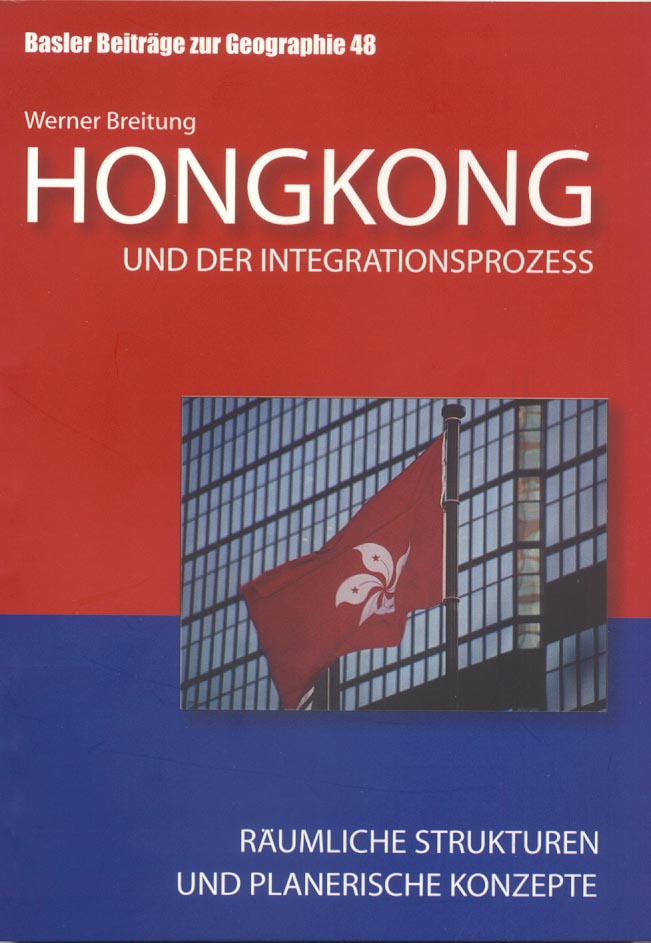|
BREITUNG, Werner: Hongkong und der Integrationsprozess - Räumliche Strukturen und planerische Konzepte. (= Basler Beiträge zur Geographie, Bd. 48), Wepf & Co., Basel 2001 228 S. (mit 62 Abbildungen,
27 Tabellen
Globalstädte sind die Knotenpunkte im weltweiten Netz der Metropolen. Welche funktionalen Verbindungen bestehen zwischen ihnen? Welchen inneren Wandlungsprozessen sind sie dadurch selber unterworfen? Diese Arbeit untersucht aufbauend auf langjährigen Aufenthalten in Hongkong und empirischen Analysen solche funktionalen Verbindungen und Veränderungen der wirtschafts- und sozialräumlichen Struktur Hongkongs in den 1990er Jahren und setzt sie in Beziehung zu externen Determinanten. Es zeigen sich Parallelen und interessante Unterschiede zwischen Hongkong und anderen (westlichen) Globalstädten. Gleichzeitig unterliegt Hongkong jedoch noch einem weiteren grundlegenden äußeren Einfluss. Neben der Intensivierung seiner globalen Vernetzung erfährt es durch die Integration mit der Volksrepublik China auch einen Aufbau regionaler Netzwerke. Die Grenze zum chinesischen "Mutterland" besteht weiter, verliert aber allmählich ihre trennende Wirkung. Hongkong befindet sich am Ende des 20. Jahrhunderts in einem zweifach veränderten Wirkungsfeld politischer, ökonomischer und kultureller Kräfte. Diese Arbeit zeigt auf, wie sich die globale und regionale Integration Hongkongs raumstrukturell niederschlägt und untersucht die damit verbundenen stadtplanerischen Reaktionen und Herausforderungen. Fallbeispiele illustrieren planerische Konflikte, Akteure und Lösungsansätze. Von besonderem Interesse sind dabei das Wachstum des Central Business Districts (CBD) und die Entwicklung des grenznahen Grüngürtels in den New Territories. BREITUNG,
Werner:
Global cities are the nodes in the global networks of transport, finance and information. How exactly are they functionally linked? What internal changes are caused by their functions? This book attempts to answer these questions for the case of Hong Kong, thereby drawing on extensive local fieldwork and data analysis. It looks at the city's functional links and at changes in its economic and social fabric in the 1990's. It furthermore relates these findings to external factors and shows similarities as well as interesting variations from findings on other global cities, mostly in the West. Simultaniously Hong Kong experiences another major external change. Besides the intensifying global connectivity, regional networks are strengthened by the integration with mainland China. Although the border remains physically unchanged, it has already lost much of its impact. This book looks at the spatial impact of Hong Kong's global and regional integration and identifies the resulting challenges and reactions in urban and regional planning. Major planning conflicts, the actors involved and changing policies are illustrated by case studies, such as land reclamation in the growing central business district (CBD) and nature conservation in the New Territories. BREITUNG,
Werner:
Mondurboj estas la nodoj en la tutmondaj retoj de trafiko, financoj kaj informado. Sed kiaj estas iliaj funkciaj ligoj? Kaj kiujn internajn ŝanĝiĝojn ili kaŭzas al la respektivaj urboj? Tiu-ĉi libro celas respondi al tiuj demandoj en la kazo de Honkongo. Ĝi baziĝas sur profunda surloka esplorado kaj datumaranalizo dum la 1990aj jaroj. La esploradon de funkciaj ligoj kaj ŝanĝiĝoj de la economia kaj socia strukturoj de Honkongo ĝi rilatas al eksternaj faktoroj, montrante kaj similaĵojn kaj malsimilaĵojn al aliaj (okcidentaj) mondurboj. Samtempe al ĝia pli forta integriĝo mondskale, Honkongo spertas ankaŭ plifortigon de ĝiaj regionaj ligoj. Pro la integriĝo kun Ĉinio la landlimo jam iom perdis ĝian efikon, kvankam fizike kaj laŭleĝe ĝi restis same. Tiu libro esploras la spacajn konsekvencojn de ambaŭ integriĝoj kaj montras la rezultantajn konfliktojn kaj reagojn de urboplanado en Honkongo. Detalstudoj analizas la plej gravajn konfliktojn, la agantojn kaj trovitajn solvojn, ekzemple rilate a la kreskanta komerca centro (CBD) kaj al naturprotektado en la "Novaj Teritorioj" prokcime al la landlimo.
Le
processus d’intégration socio-spatial à Hongkong
Sous
la direction du professeur Rita Schneider-Sliwa, Werner Breitung à maîtrisé
une recherche complexe en consacrant sa thèse de doctorat au rôle joué
par les structures spatiales et les concepts de planification dans le processus
d’intégration métropolitaine de Hongkong. L’étude est d’autant
plus intéressante qu’elle intègre les mutations en cours depuis le
retour du Territoire à la Chine. Elle s’appuie sur une riche bibliographie,
tant relative à la problématique locale qu’orientée vers l’analyse
théorique des rapports entre les fonctions mondiales d’une métropole
et son substrat socio-spatial. L’appareil cartographique, souvent en
couleur, constitue une solide base de référence et de documentation.
Le texte se fonde en outre sur de nombreux graphiques, diagrammes, schémas
et photographies, très expressifs des questions étudiées. Des résumés
et récapitulations systématiques rendent la lecture aisée.
|
